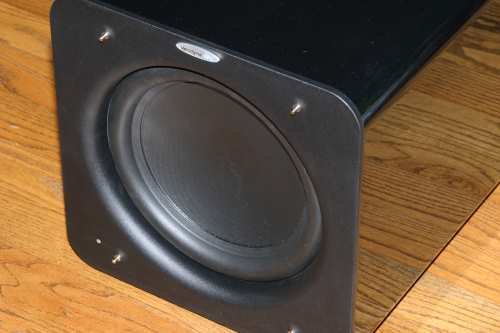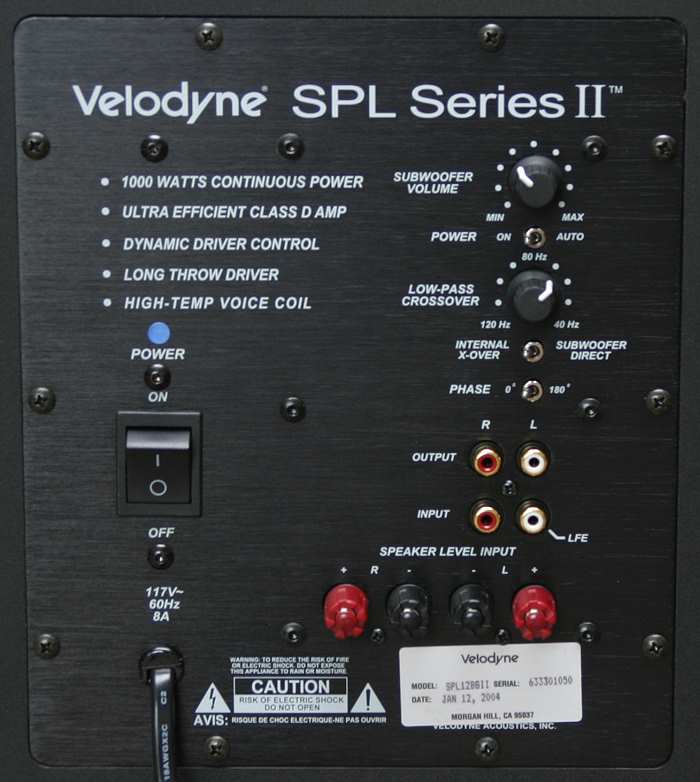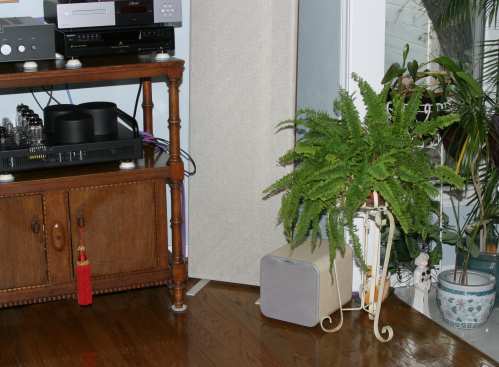Getting Big Bass in Small Places - Velodyne's New Series II SPL-800, SPL-1000, and SPL-1200 Subwoofers February, 2004 John E. Johnson, Jr.
|
Introduction
I don't imagine there is anyone out there shopping for home theater equipment
who does not know how important a subwoofer is for the movie experience.
Deep bass is something that you not only can hear, but you can feel
it too. And, as we get older, although our ability to hear high
frequencies deteriorates, the ability to hear low frequencies seems to
stay with us (personal experience). So, a good subwoofer is a requisite
component.
To get low frequencies in our audio systems, the speaker has to move a lot of air. Up until just a couple of years ago, this meant having a very large enclosure with a big driver inside, as well as a big amplifier. And, they were expensive.
There were small subwoofers available, but they were little more than bare extensions of our main speakers because the drivers could not move much air, i.e., they did not have much excursion (the distance they could move back and forth was limited). Also, powerful amplifiers could not fit in the small enclosures, so they tended to be products with 80 watt amplifiers, when you really need much more to do the job right.
That all changed with the advent of digital switching amplifiers (Class D) and drivers with excursion in the realm of inches rather than millimeters.
Velodyne's HGS series, about 7 years old now, was their first in this type of design. Their new SPL Series II brings this same kind of performance to a price point that anyone can afford, the main difference being that the SPL Series does not have servo-feedback (a motion sensor on the driver that feeds information back to the amplifier to reduce distortion down to the 1% - 2% level).
This brings us to the question as to why anyone would bother with a small subwoofer, when it is easier to get deep bass with a big one. Well, many consumers don't have the space for a large enclosure (we are talking about something that takes up as much space as an end table). They might have a small apartment, or be a student in a dormitory, or just want to put it in a room that isn't very big. Also, a big box can overpower a room in the decor department. Some people just don't want a big speaker enclosure to be sitting there, drawing attention.
The Design
The SPL Series II subwoofers are designed to deliver big bass from small enclosures, and be affordable. These include the SPL-800II, SPL-1000II, and SPL-1200II, which have 8", 10", and 12" drivers respectively. They have large excursion, on the order of at least 1", and digital switching amplifiers that output 1,000 watts RMS. This differs from the SPL Series I, which had smaller amplifiers. The amplifier is critical because to move the driver back and forth that large excursion takes plenty of power, especially in a small enclosure.
The HGS Series is also small, with big amplifiers, but uses solid state servo-feedback, which consists of a small solid state motion sensor mounted on the voice coil. The sensor detects the actual motion (the acceleration) of the driver and sends this information back to the input stage of the power amplifier, which calculates the difference between what the amplifier is telling the driver to do, and what it is actually doing. This difference is inverted electrically, and sent back through the amplifier to counteract the false movements of the driver (this is the distortion).
Servo-feedback is marvelous technology. However, there is a price. It takes a huge percentage of the amplifier's power to counteract the distortion movements, and this takes away from the overall loudness that the subwoofer can produce. The SPL Series II by comparison, uses an impedance feedback rather than the solid state servo, but retains a large powerful amplifier and large excursion driver. The result is a subwoofer that can produce a louder bass in the same sized enclosure as the HGS subwoofers. Since the drivers are designed with low distortion in mind in the first place, the SPL subwoofers still have low distortion, and can give you sufficient bass for the home theater experience you want.
All three SPL Series II subwoofers have the same amplifier, and essentially the same driver, but with different piston sizes. They use large voice coils and have extremely heavy magnets. The rubber surround is thick, in keeping with the large excursion.

They come in three different finishes - gloss black, cherry, and maple - to fit in with just about any room decor.
The amplifier panel has a full array of inputs and settings to make it work with any subwoofer output that you need to use. Although there are both line-level input jacks (for connecting to the subwoofer output jack on the receiver) and speaker level input connectors (you would connect these to the speaker output posts on the receiver), I feel it is best to always use the line-level inputs where possible.

The low-pass adjustment lets you limit the frequencies that the subwoofer reproduces. Setting it to 40 Hz means that the subwoofer will reproduce all frequencies below 40 Hz, and setting it to 120 Hz will limit it to 120 Hz and below. If you have large main speakers, you would probably set it to 40 Hz to start with. If you have small speakers, then perhaps 80 Hz to 100 Hz would be the appropriate setting. With any subwoofer, it is always best to experiment, even if the first setting sounds good. It won't hurt to change the settings, and it is part of the fun of having nice hi-fi equipment.
Placement
Although placement of your main speakers, center speaker, and surround speakers is limited (they are supposed to go in specific spots in relation to the TV and where you are sitting), the subwoofer can be placed just about anywhere. However, that does not mean you should put it down in the first open spot in the room and forget about it. Placement of a subwoofer is important too, you just have more flexibility here.
The photo below shows how an SPL-800II just disappears into the decor, using the maple finish, sitting next to a Magnepan speaker. I tilted the Magnepan for the photo, but in use, I could actually put the SPL behind it, and the Magnepan out from the wall about a foot. I used the plant to show how the subwoofer can be camouflaged, but just be careful when you water the plant! The cherry finish also looked nice here, next to the oak floor and cabinet.

Regardless of which SPL model you might purchase, there is a nice trick you can use to place it. Assuming you have connected the subwoofer to your receiver and adjusted it to the low-pass setting you plan to use (for the time being) and a reasonable volume level, you place it at ear level in the spot where your chair is that you sit in when watching movies. You might have to use a step ladder for this (be careful it does not fall off, maybe have a friend stand there with his hand to hold the subwoofer steady). Now, put on a DVD with plenty of bang, such as the Pod Race scene from "Star Wars", "Terminator 2", etc. Any movie with lots of bass action will do. Then, with the movie playing, go around the room on your hands and knees and find the spot where you hear the bass the best. That is the spot to place your new subwoofer (or an old one if you haven't bothered to place your subwoofer carefully). If it is an inconvenient spot, such as a doorway, then find the next best spot that is convenient. Remember, the SPL Series can fit behind a couch, under a coffee table, behind the TV, etc. So, stick your head in those places to see how the bass sounds. Placement in a corner often augments the bass, called corner loading, so don't forget to try that option.
As to which model you should purchase, I would suggest getting the biggest one you can handle, as laws of physics simply mean the bigger box will give you deeper bass, and even the 12" model is only about a foot cubed. However, if size is critical, the 8" model is small enough to fit anywhere, even on a shelf (but keep it as close to the floor as possible), and it still does very well in the low frequencies.
The Listening
In testing the three SPL Series II subwoofers, I found that the maximum loudness (SPL) for each model, at 31.5 Hz, calibrated microphone 1 foot from the front of the subwoofer, was as follows:
SPL-800II - 110 dB
SPL-1000II - 112 dB
SPL-1200II - 116 dB
This is very good performance for small subwoofers and is testimony to what a large excursion driver with a powerful amplifier can do in a small box. Such performance was not an option just a short time ago. The distortion at high level went down with each higher model number, and that is to be expected.
I tested the SPL subs with our two channel audio system as well as in our home theater lab. They sounded very good with all types of program material, including SACD and DVD-A, as well as big movies, such the attack scene in "Pearl Harbor". Obviously, the 8" version will not blow out the windows, but that is not its purpose. Nevertheless, it still provided ample bass in our tests.
What surprised me is the quality of the bass coming from these small boxes. Velodyne's latest drive design technology, plus that 1,000 watt amplifier, produces a bass quality that rivals much larger designs from other companies. At common loudness settings (100 dB), they sound almost like the HGS subwoofers.
Conclusions
If you are in the market for subwoofers, and are constrained by room size or simply the appearance that a large box has, your options just increased by three. The Velodyne SPL Series II subwoofers are high tech, high performance, but not high priced. In their size category, they are some of the very best subwoofers out there, and they indeed deliver big bass in small places.
- John E. Johnson, Jr. -
|
© Copyright 2004 Secrets of Home Theater & High Fidelity |
![]()




